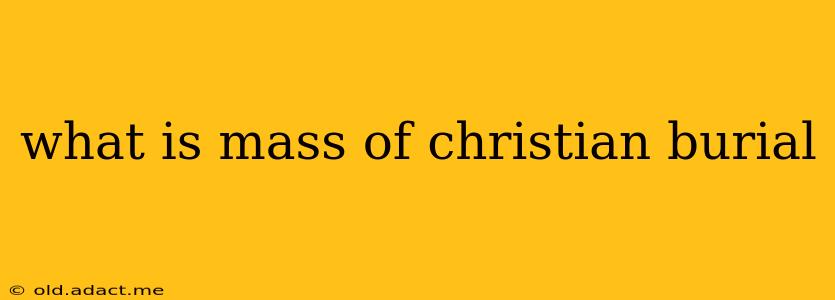The Mass of Christian Burial, also known as a Requiem Mass, is the primary liturgical funeral rite in the Catholic Church. It's a sacred celebration of the life of the deceased, acknowledging their earthly passing and entrusting their soul to God's mercy. It's not simply a memorial service; it's a full liturgical Mass, incorporating prayers, readings, and the Eucharist, emphasizing the Christian belief in the resurrection and eternal life.
What are the key components of a Mass of Christian Burial?
A Mass of Christian Burial typically follows a specific structure, though variations exist depending on local customs and the preferences of the deceased and their family. Key components include:
- The Entrance Procession: The casket, often adorned with flowers, is carried into the church, symbolizing the entry of the deceased into the presence of God.
- The Opening Rites: These include the gathering of the community, the opening prayer, and the Penitential Rite, where mourners acknowledge their sins and seek God's mercy.
- The Liturgy of the Word: Scripture readings, chosen to offer comfort and hope, are proclaimed, followed by a homily (sermon) reflecting on the life of the deceased and the Christian message of resurrection.
- The Liturgy of the Eucharist: This is the central part of the Mass, where bread and wine are consecrated and offered as a sacrifice for the deceased and all the faithful. The Eucharist represents the body and blood of Christ, offering spiritual nourishment and strengthening faith.
- The Intercessions (Prayers of the Faithful): Prayers are offered for the repose of the soul of the deceased, for their family, and for all those who mourn.
- The Commendation: A final prayer commends the soul of the deceased to God's loving mercy.
- The Dismissal: The concluding rite where the priest blesses those gathered, and the community is dismissed.
Is a Mass of Christian Burial required for Catholics?
While strongly encouraged for practicing Catholics, a Mass of Christian Burial is not mandatory. The Church recognizes that various circumstances may prevent it, and other funeral rites may be offered. However, the Mass is considered the most fitting and complete expression of the Church's faith in the context of death and the afterlife.
What is the difference between a Mass of Christian Burial and a funeral service?
While both are funeral rites, the Mass of Christian Burial is specifically a Catholic liturgical celebration centered around the Eucharist. A funeral service can be more ecumenical or non-religious, encompassing a broader range of traditions and practices, and may not include the Eucharist or specific Catholic prayers.
What happens to the body after a Mass of Christian Burial?
After the Mass, the body is typically taken to its final resting place – either burial in a cemetery or cremation followed by interment of the ashes. The specific arrangements are made according to the family's wishes and the local customs.
Can non-Catholics attend a Mass of Christian Burial?
Absolutely! The Catholic Church welcomes all who wish to participate in prayer and support for the family of the deceased. While non-Catholics may not fully participate in the Eucharist, their presence is a sign of solidarity and compassion.
What are the prayers said during a Mass of Christian Burial?
The specific prayers vary depending on the chosen liturgical texts, but common themes include prayers for the deceased's soul, expressions of faith in the resurrection, and petitions for comfort and strength for the grieving family. Many prayers are drawn from traditional Catholic liturgy.
This comprehensive overview should provide a clear understanding of the Mass of Christian Burial. Remember, the true essence of this rite lies in its profound expression of faith, hope, and love, offering comfort and solace to the bereaved while celebrating the life of the deceased.
